Motivation
The rapid proliferation in the number of smart mobile devices combined with a similar trend in bandwidth-hungry applications, result in a looming spectrum crisis. Industry and academia are gearing to meet the 1000x challenge, where the demand for wireless spectrum in 2020 is expected to be 1000x of that in 2010. The idea of extending LTE-A services into the unlicensed 5 GHz bands (a.k.a., LTE-Unlicensed) is considered as a potential solution. LTE operators supplement their licensed -uplink (UL) and -downlink (DL) services by leveraging a secondary anchor in unlicensed spectrum (see Figure 1). The LTE-U support for downlink over unlicensed spectrum is now part of 3GPP Rel-13 standard, while the support of uplink is expected to take place in Rel-14. In addition to LTE-U, an alliance of major industrial bodies are now working on a standalone LTE design, known as MulteFire, that operates fully over unlicensed bands.
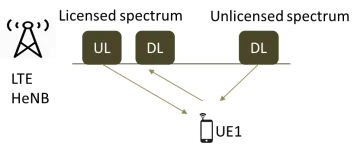
Figure 1: Spectrum allocation for future LTE (UE: User Equipment).
Extending LTE into unlicensed bands creates a new eco system wherein LTE networks and incumbent systems, including Wi-Fi, Zigbee, and Bluethooth, compete for a common shared resource (see Figure 2). Achieving a harmonious LTE/Wi-Fi coexistence is extremely challenging, due to the unreliable nature of the unlicensed spectrum and the equal rights of spectrum access. The difference in signal structure, channel access, and traffic intensity of these systems raise many issues regarding the fairness, stability, and spectrum efficiency. Resource management protocols and sophisticated coexistence algorithms are needed for ensuring a harmonious operation of these systems. In this project, we tackle down relevant challenges and introduce solutions for achieving a harmonious coexistence.
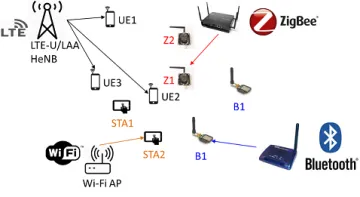
Figure 2: Coexistence in the unlicensed bands.
LTE-U Background
Two main channel access schemes are proposed to enable LTE-U over unlicensed bands, namely, the carrier-sense-adaptive transmission (CSAT) and the licensed-assisted access (LAA). In CSAT, home eNodeB (HeNB) abandons transmitting frames for an OFF period, giving Wi-Fi devices the opportunity to access the spectrum (see Figure 3). HeNB adapts its duty cycle after estimating the number of neighboring Wi-Fi STAs during the OFF period. In LAA, LTE devices perform a listen-before-talk (LBT) procedure, similar to CSMA in Wi-Fi, before transmitting. The duty-cylce-based channel access is considered as a short-term solution while the LBT-based solution is considered as a long-term one. LAA is also considered to be the channel access scheme for the MulteFire framework.
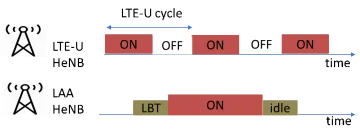
Figure 3: LTE-U and LAA operations.
Thrust 1. Spectrum Sensing in Heterogeneous Coexistence and Fairness Mechanisms
We investigate the potential of cross-technology detection schemes in improving the performance of coexisting systems. For example, Wi-Fi access point (AP) detects potential collisions with LTE-U signals, enabling the AP to either backoff earlier or switch to a new channel (see Figure 4). In our scheme, Wi-Fi AP tunes to unique features in LTE signals, the cyclic prefix, for detecting the presence of LTE-U signals. We exploit self-interference suppression (SIS) capabilities for allowing Wi-Fi to execute a simultaneous-transmission-and-sensing, making the AP more aware about LTE-U dynamics.
Enabling cross-technology detection for LTE and Wi-Fi motivates the redesign of their clear-channel-assessment (CCA) thresholds for achieving higher fairness between the two systems. We study the optimal (fairwise) CCA thresholds that should be used by these systems, taking into account various systems' dynamics. The outcome of this study is a new CCA threshold adaptation map for Wi-Fi devices (see Figure 5).
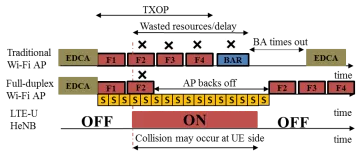
Figure 4: Early collision detection enhances Wi-Fi performance ('F1': frame 1, 'S': sense, EDCA: enhanced distributed channel access).

Figure 5: New CCA threshold map (BSS: basic service set, OBSS: overlapped BSS).
Thrust 2. Symmetric Full-duplex Communications in Heterogeneous Coexistence
Exploiting SIS capabilities in coexistence eco system has not yet received enough considerations. SIS provides two advantages: (1) boosting system's performance through bidirectional simultaneous transmission-and-reception (a.k.a., TR mode), and (2) enhancing system's awareness about potential interference through simultaneous transmission-and-sensing (a.k.a., TS mode). The adaptation between TR and TS modes in LTE/Wi-Fi settings deserves more investigation. In this thrust, we investigate the problem of jointly adapting the transmission rates, modulation-coding-scheme indices, and duplex-mode of a symmetric Wi-Fi link (i.e., a full-duplex link between Wi-Fi AP and STA), as shown in Figure 6. Wi-Fi AP operates in one of two duplex modes as shown in Figure 7. We model this problem using a Markov-decision-process framework, and study the impact of various systems' dynamics. We also investigate the required protocol changes needed for accommodating this operation. The toy example shown in Figure 8 depicts how the new scheme works; Wi-Fi AP and STA start by exchanging frames in a TR mode with 64QAM modulation. The first transmitted frames (F11 and F21) are lost due to collisions with LTE-U transmission. Wi-Fi AP switches to the TS mode and uses a lower modulation index (e.g., QPSK) and retransmits frame F11 again. The retransmitted frame happens to be received successfully. The sensing capabilities allow the AP to better adapt transmission rates and duplex modes for subsequently transmitted frames, taking into account LTE-U dynamics.
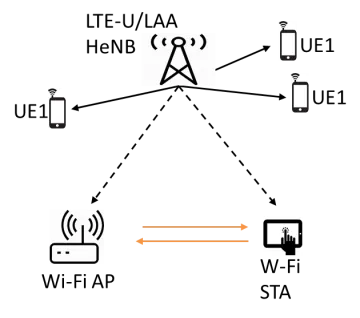
Figure 6: LTE-U/Wi-Fi coexistence topology.
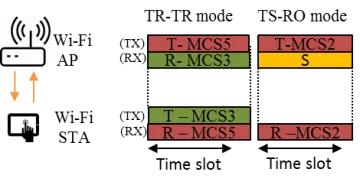
Figure 7: Symmetric full-duplex communication modes.

Figure 8: Example of symmetric full-duplex communication with interference caused by LTE-U (TXOP: transmit opportunity).
Thrust 3. Asymmetric Full-duplex Communications in Heterogeneous Coexistence
We study exploiting of SIS capabilities in LTE/Wi-Fi coexistence for asymmetric full-duplex topology. Wi-Fi AP is full-duplex enabled, while STAs are half-duplex (see Figure 9). We study the adaptation of transmission rates and UL/DL activation while Wi-Fi links coexist with LTE-U HeNB. We propose three modes of operation, uplink only (UL), downlink only (DL), and simultaneous UL and DL (a.k.a., full-duplex AFD), as shown in Figure 10. We investigate relevant challenges and propose a new enabling protocol design.
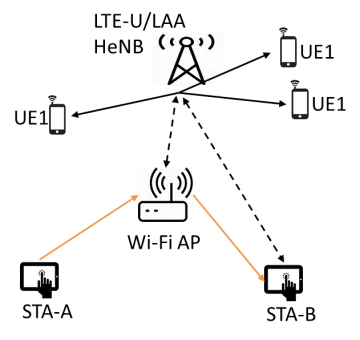
Figure 9: LTE-U/LAA and Wi-Fi Coexistence topology with half-duplex Wi-Fi STAs.
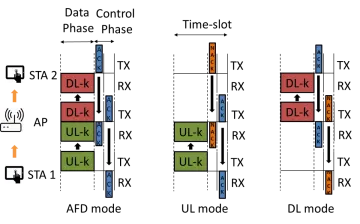
Figure 10: Asymmetric full-duplex modes.
Thrust 4. Media Streaming over LTE Small Cells in the Unlicensed Bands
Among different traffic types transmitted over wireless channels, video traffic is considered the main reason for the expected spectrum crisis, as it requires relatively high data rates with strict bounds on packet loss rates, delay, and delay jitter (especially for real-time video communications). According to Cisco, by 2018 over two-thirds of the world’s mobile data traffic is expected to be video traffic. Not to overwhelm band-limited networks, video compression algorithms are always employed to reduce the storage and transport requirements of streamed video. This is typically done by removing spatial and temporal redundancies inherent in video sequences, which in turn results in interdependencies between different types of video frames. Specifically, independently encoded video frames are needed to encode/decode consecutive dependent frames. Such interdependency, place additional burden on the design of efficient video communication systems.
We consider video streaming over LTE small cells in the unlicensed bands. In addition to the classical challenges faced by video streaming over wireless links (e.g., limited throughput, fast-varying BER, fading, etc.), there are some unique challenges that result from LTE-U/Wi-Fi coexistence. These challenges are related to the nature of operations of the two schemes, since Wi-Fi networks rely on contention-based channel access, while LTE-U small cells are schedule-based. Furthermore, channel availability in the unlicensed band is dynamic due to random channel access of the Wi-Fi STAs. Clearly, this also makes video transmission on these channels by the HeNBs quite challenging. Losing important (referenced) video frames, due to collisions with Wi-Fi signals, will not only cause degradation in the quality of the reconstructed video due to error propagation, but might lead to severe interruptions at UEs because of the interdependencies between video frames.
To address the aforementioned problems, we propose an adaptive channel assignment scheme for video streaming over LTE small cells. The proposed scheme adaptively assigns video frames to available channels, leveraging the CA/SDL features in LTE. The objective of our adaptive scheme is to reduce possible starvation instants at UEs, and hence maintain continuous video playback. We formulate the frames’ assignment problem as an optimization problem, which takes into account the quality of the monitored channels, the Wi-Fi activity on the unlicensed channels, the occupancy of the playback buffers at UEs, in addition to the deadlines and priorities of transmitted video frames. The assignment process targets the maximization of the probability of correct reception of video frames. To enable online-monitoring of channels, we exploit SIS techniques, where the HeNB carries out in-band spectrum sensing for the unlicensed channels.
Related Publications
- Mohammed Hirzallah, Yong Xiao, and Marwan Krunz, “On Modeling and Optimizing LTE/Wi-Fi Coexistence with Prioritized Traffic Classes,” accepted for the IEEE International Symposium on Dynamic Spectrum Access Networks (DySPAN’18), October 2018, Seoul, South Korea.
- Mohammed Hirzallah, Yong Xiao, and Marwan Krunz, "Modeling cross-technology coexistence with prioritized traffic classes," University of Arizona, Department of ECE, TR-UA-ECE-2018-2 (last updated: Aug. 15th, 2018).
- Yong Xiao, Mohammed Hirzallah, and Marwan Krunz, "Optimizing Inter-operator Network Slicing over Licensed and Unlicensed Bands," accepted to appear in the IEEE SECON 2018 Conference, Hong Kong, June 2018.
- Mohammed Hirzallah, Wessam Afifi, and Marwan Krunz, "Full-duplex-based rate/mode adaptation strategies for Wi-Fi/LTE-U coexistence: A POMDP approach," IEEE Journal on Selected Areas in Communications (JSAC) - Special Issue on Spectrum Sharing and Aggregation for Future Wireless Networks, vol. 35, no. 1, pp. 20-29, Jan. 2017.
- Mohammed Hirzallah, Wessam Afifi, and Marwan Krunz, "Full-duplex adaptation strategies for Wi-Fi/LTE-U coexistence," University of Arizona, Department of ECE, TR-UA-ECE-2016-3 (last updated: Nov. 18, 2016).
- Mohammed Hirzallah, Wessam Afifi, and Marwan Krunz, “Full-duplex spectrum sensing and fairness mechanisms for Wi-Fi/LTE-U coexistence,” Proc. of the IEEE GLOBECOM 2016 Conference, Washington D.C., Dec. 2016.
- Wessam Afifi, Mohammed Hirzallah, and Marwan Krunz, "Integrating full-duplex capabilities in heterogeneous spectrum sharing" (invited paper), Proc. of the 50th Asilomar Conference on Signals, Systems and Computers, Pacific Grove, California, Nov. 2016.
- Wessam Afifi, Mohammed Hassan, and Marwan Krunz, “ Enabling media streaming over LTE-U small cells", In Proceedings of the IEEE WCNC 2016 Conference, Doha, Qatar, April 2016.
